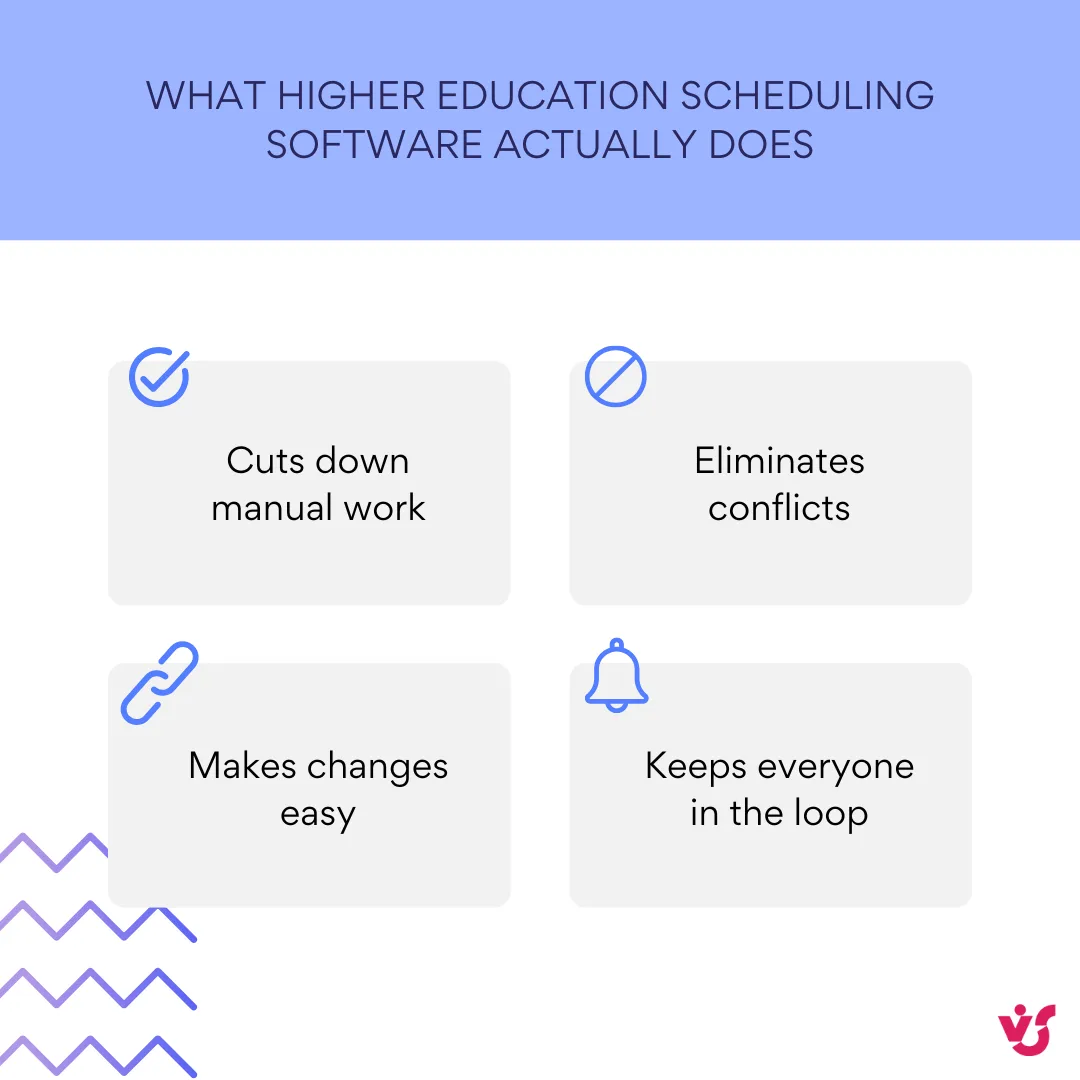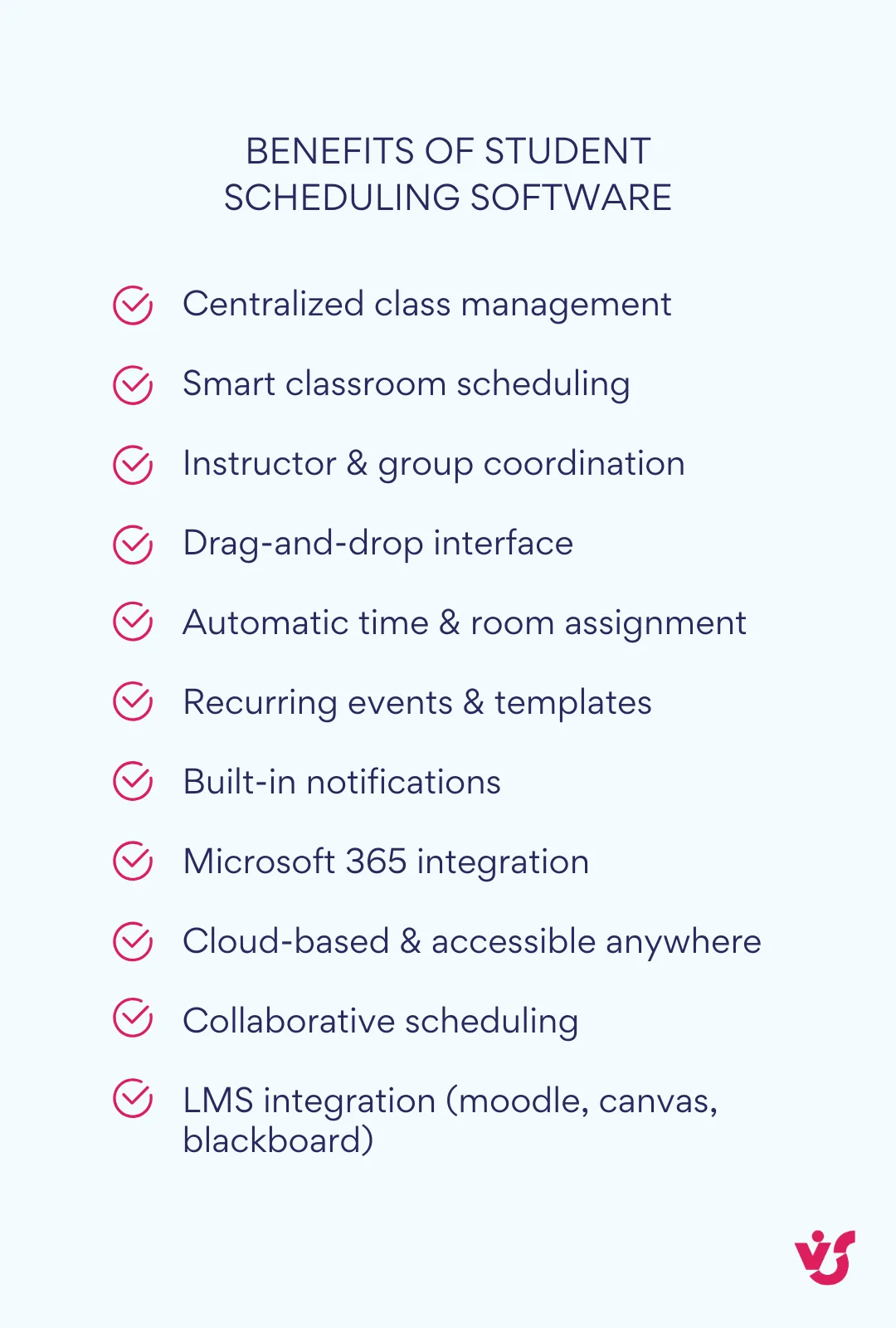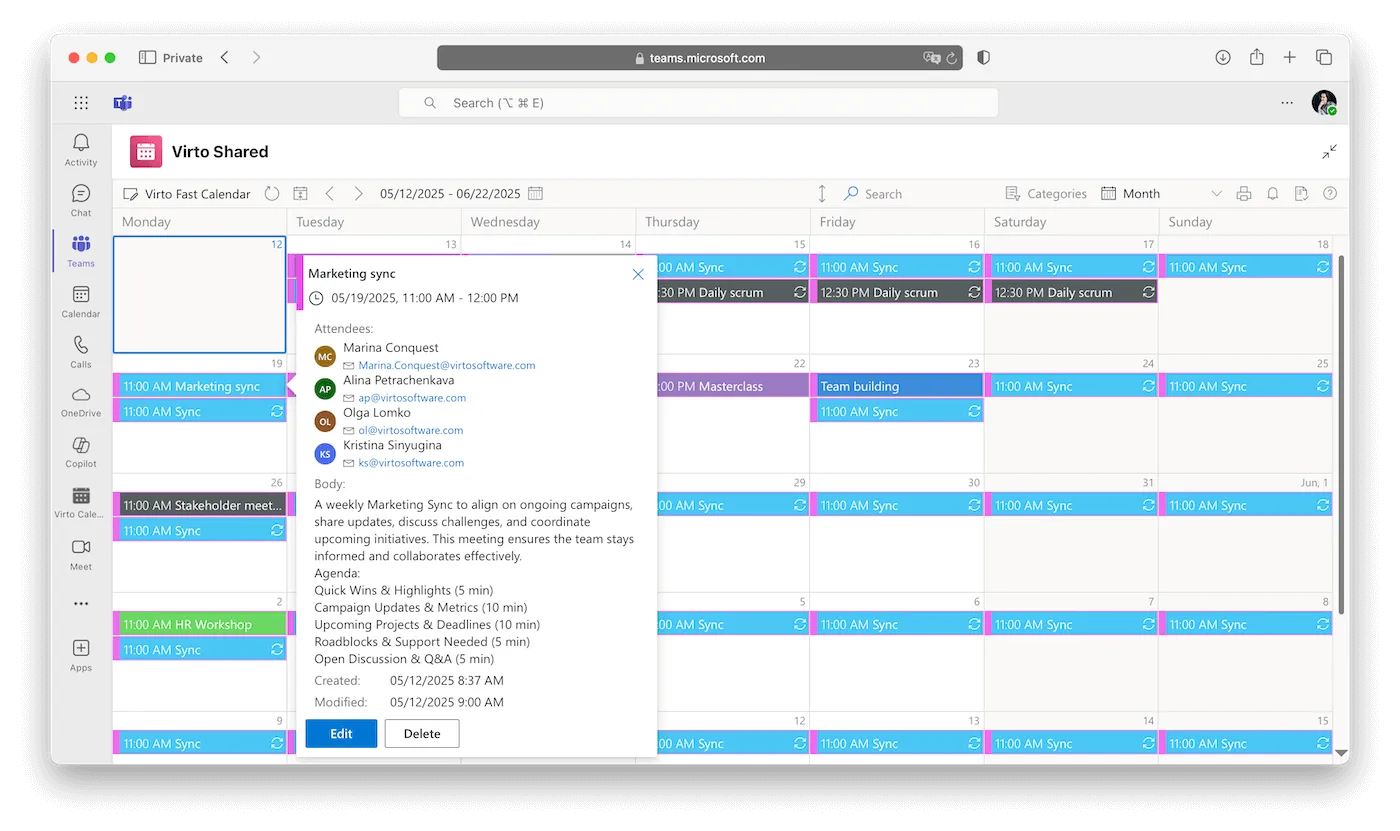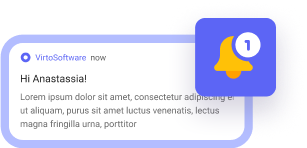Managing class schedules at universities and colleges often feels like solving a Rubik’s Cube blindfolded. Double-booked classrooms, overworked professors, last-minute cancellations, and a general fog of “Who’s teaching what, when, and where?” It’s chaos with a side of confusion.
This article is here to untangle that mess. We’re diving into how student scheduling software and other purpose-built tools can bring order to the madness—no more spreadsheet gymnastics or frantic hallway rescheduling.
Whether you’re looking for college scheduling software, university scheduling software, or a more flexible online class scheduling software, we’ll help you navigate your options. We’ll walk through the different types of academic scheduling software, the essential features to look for, and how to choose the right class scheduling tool that actually works for your institution.
We’ll also show you how the Virto Shared Calendar App can make life easier—whether you’re managing a single department or coordinating across an entire campus. Think of it as your personal assistant, but with better memory and no office drama.
So if you’re an IT specialist ready to integrate better software for class scheduling, or an admin just trying to avoid another email titled “Schedule Confusion—Help!”, this guide’s for you. From classroom scheduling software and college course scheduling software to class scheduler software and online student scheduling software, we’ve got the tools (and tips) to bring your calendar back under control.
Let’s fix the schedule—together.
👉 Start here with a helicopter view on scheduling:
- Transforming Education with School Scheduling Software: Top Solutions in 2025
- Optimize Classroom Scheduling with Advanced Software Solutions: An Expert Guide
What Is Student Scheduling Software—And Why Should You Care
Picture this: one tool that handles class times, professor availability, classroom capacity, exams, workshops, and even last-minute schedule changes… without giving you a spreadsheet-induced headache. That’s the magic of student scheduling software.
At its core, student scheduling software is a specialized solution built to manage the chaos of academic timetables—be it for students, instructors, or the institution as a whole. Whether you’re in a university, college, academy, or any kind of educational organization, these tools are designed to automate the planning of classes, meetings, exams, consultations, labs, and more.
So, how is this different from the “good old” days of Google Sheets and endless email chains? Here’s the twist: instead of juggling a dozen tabs and hoping for the best, class schedule software gives you a centralized, flexible, and intelligent environment where you can factor in everything—professor availability, classroom occupancy, curriculum structure, and even group preferences.
👉What is student scheduling software? Student scheduling software is a specialized tool designed to streamline the planning and management of academic schedules in colleges, universities, and other educational institutions. It automates the process of organizing classes, exams, meetings, and other academic activities by factoring in variables like instructor availability, room occupancy, course requirements, and student groups. Unlike traditional manual methods using Excel or Google Sheets, this software provides a centralized, flexible, and error-resistant environment—helping administrators avoid conflicts, save time, and ensure everyone stays informed.
Let’s break down what this type of higher education scheduling software actually does:
✅ Cuts down manual work
Creating schedules by hand is time-consuming and, let’s face it, error-prone. Software for class scheduling automates those repetitive tasks, freeing up time for academic coordinators to focus on what really matters—supporting students and improving programs.
🚫 Eliminates conflicts
Say goodbye to students expected in two places at once or double-booked lecture halls. Good class scheduler software automatically detects timing conflicts, overlapping locations, and instructor clashes—before they become an email crisis.
🔁 Makes changes easy
Need to switch a room? Reassign an instructor? Shift a class by 30 minutes? With academic scheduling software, changes are seamless and instantly reflected across the system. Everyone involved gets notified—no more last-minute confusion.
🔔 Keeps everyone in the loop
Modern online student scheduling software comes with built-in notifications and reminders. Perfect for hybrid or remote learning environments where students and instructors rely on real-time updates to stay on track.

👉Why do you need student scheduling software? You need student scheduling software because manual scheduling is time-consuming, error-prone, and simply not scalable for today’s academic environments. Whether you’re managing hundreds of students, juggling overlapping classes, or coordinating hybrid learning formats, this software helps eliminate conflicts, automate routine tasks, and adapt to changes instantly. It ensures everyone—students, instructors, and admins—stays on the same page with real-time updates and notifications, making your entire scheduling process smoother, smarter, and far less stressful.
Here’s where course scheduling software and school class scheduling software shine:
- Technical and liberal arts colleges use it to manage labs, workshops, and modular course structures.
- Large universities rely on it to coordinate massive student bodies, complex programs, and international departments.
- Online and distance-learning institutions depend on it to keep virtual classes, exams, and office hours running like clockwork.
Whether you’re after scheduling software for colleges, scheduling software for universities, or simply a better way to manage student calendars, the right class scheduling tool turns chaos into clarity.
And yes, we’ll also show you how the Virto Shared Calendar App fits into this picture—because your time (and sanity) deserves better than Excel.
Key Features and Benefits of Student Scheduling Software
Let’s talk about what makes student scheduling software more than just a fancy calendar. This isn’t your average class list—it’s a full-on command center for organizing lectures, managing resources, syncing calendars, and keeping everyone in the loop. Here’s what sets top-tier college scheduling software and university scheduling software apart:
🎓 Smarter class and schedule management
From giant lectures to small-group seminars, school class scheduling software helps you build and manage every piece of your academic puzzle. Whether you’re planning labs, workshops, or cross-faculty electives, the platform brings it all together into one centralized, conflict-free schedule.
Bonus: It’s built to scale. Got dozens of departments or complex modular programs? No problem—course scheduling software keeps it all tidy.
🏫 Room and resource allocation that actually makes sense
With classroom scheduling software, you don’t just book a room—you assign the right one. The system checks room capacity, equipment (projectors, lab gear, etc.), and availability before locking it in. Say goodbye to “Oops, this class needs a microscope, not a whiteboard” moments.
👥 Instructor and group matching, without the spreadsheet struggle
Class schedule software tracks instructor availability, teaching loads, and student group assignments to avoid overlaps and burnout. It helps you balance the workload and reassign tasks in just a few clicks when things shift.
⚙️ Flexibility meets automation
- Drag and drop editing
Need to move a class to Friday afternoon? Just drag it. Done. No digging through Excel tabs or updating ten separate sheets. - Automatic assignment of time & rooms
Set your rules, priorities, and constraints—and let the class scheduling tool handle the rest. It’ll find the best fit for time, room, and instructor. - Recurring classes & templates
Classes that happen every week? Create once, repeat forever. Templates keep things efficient and consistent across semesters.
📢 Built-in communication & notifications
Forget manual emails. With online student scheduling software, updates go out automatically to students and instructors when something changes. No one’s left wondering if class is canceled, moved, or still happening.
Plus, with integrations into Microsoft Teams, Outlook, and other calendars, your schedule shows up where your users already work. It’s perfect for institutions using Microsoft 365—no more copy-pasting between platforms.
☁️ Online access, real-time collaboration
Modern scheduling software for universities is cloud-based, meaning your staff, faculty, and students can access it from anywhere. Whether you’re supporting remote learning, coordinating across campuses, or just want freedom from your desk—it’s got you covered.
And with shared access across departments and admins, everyone works from the same, always-up-to-date schedule.
🎓 LMS integration for seamless academic flow
Need to connect schedules with assignments and course materials? Many college course scheduling software solutions integrate with learning platforms like Moodle, Canvas, or Blackboard. This means a tighter connection between time management and actual course delivery—for students and staff alike.
Bottom line? Whether you need software for student scheduling, scheduling software for colleges, or just a better way to stay on top of it all, today’s solutions are more powerful, connected, and user-friendly than ever. Scheduling doesn’t have to be a nightmare—with the right class scheduler software, it can actually be kind of fun.

Types of Student Scheduling Software
When it comes to choosing the right student scheduling software, there’s no one-size-fits-all. Different institutions have different needs—and luckily, the market has options to match. Whether you want full control, fast deployment, or seamless integration with your existing tools, here’s a side-by-side look at the major types:
| Type | Key benefits | Limitations | Best fit for |
| 🖥️ On-Premise (Local Installations) Think full control, full responsibility. Installed on your own servers, managed by your IT team. | ✔️Total customization for your internal processes ✔️Full control over data, access, and security ✔️No dependency on external APIs or cloud platforms | ❗️High setup and maintenance costs ❗️Requires dedicated IT team ❗️Limited scalability and remote access | ✔️Large universities with in-house data centers▸ Institutions with strict data policies ✔️Offline-first organizations |
| ☁️ Cloud-Based Scheduling Software Hosted by the vendor, accessed via browser or app. No local install, just log in and go. | ✔️Fast to deploy and easy to maintain▸ Accessible from anywhere with internet ✔️Auto-updates and backups▸ Scales easily across departments and campuses | ❗️Needs reliable internet connection ❗️Data stored by third party (raises security flags for some) ❗️Custom tweaks often need vendor involvement | ✔️Hybrid or online colleges/universities ✔️Institutions without a full-time IT department ✔️Startups or modern digital-first schools |
| 📅 Microsoft 365 & Teams-Integrated Tools Built into platforms you already use—like Teams, Outlook, or Microsoft calendars. | ✔️Seamless experience for users in Microsoft ecosystem ✔️Easy sync with Outlook and Teams ✔️Supports SSO and corporate security protocols ✔️Class calendars right inside Teams | ❗️All users need Microsoft 365 licenses ❗️Limited by Microsoft’s native feature set ❗️Custom support depends on Microsoft roadmap | ✔️Schools already using Teams for learning ✔️Institutions aiming to reduce IT tool sprawl ✔️Microsoft-centric educational environments |
| 🔗 API-Integrated with Other Systems Works alongside your existing LMS, CRM, or SIS. Pulls/pushes data across platforms. | ✔️Centralized data management ✔️Reduced manual data entry▸ End-to-end visibility across systems (LMS, SIS, CRM) | ❗️Needs proper integration setup ❗️May require custom development ❗️Depends on data quality from connected systems | ✔️Multi-system universities with complex infrastructures ✔️Institutions focusing on automation & unification ✔️Schools using tools like Moodle, Canvas, or Salesforce |
What Can These Tools Integrate With?
Many modern academic scheduling software platforms don’t live in a silo. They’re built to connect with:
- SIS (Student Information Systems) – for syncing groups, programs, and student data
- LMS (Learning Management Systems) like Moodle, Canvas, Blackboard – to tie schedules to course materials
- CRM – to track meetings and comms with applicants, parents, or alumni
- Microsoft Teams & Outlook – for native schedule visibility right where students and teachers already are
Whether you’re leaning toward cloud-based class scheduler software, a highly secure on-premise university scheduling software, or looking for online student scheduling software that talks to your LMS—there’s a setup for you.
The goal? A smarter, smoother, and far less frustrating scheduling experience for everyone involved.
Explore Our Scheduling Software with Virto Apps
Popular Student Scheduling Software: Who’s Who in the Scheduling Game?
Choosing the right college scheduling software or university scheduling software can feel overwhelming. So, we did the homework for you. Here’s a no-fluff overview of some of the most widely used solutions in the world of student scheduling software—what they do well, where they struggle, and who they’re really built for.
| Software | Key features | Pros | Cons | Best for |
| PeopleSoft Campus Solutions (Oracle) | -Robust ERP platform -Deep integration with SIS, grading, registration, and academic scheduling software modules -High customization for institutional needs | ✅Enterprise-grade reliability ✅Excellent for managing complex scheduling rules ✅Scales with large universities | ❌ High licensing and implementation cost ❌ Long learning curve | 🏛 Public and private universities with dedicated IT teams |
| Ad Astra Schedule | -Smart class scheduling software that focuses on data-driven optimization -Integrates with most SIS and LMS platforms -Visual drag-and-drop interface | ✅Strong predictive analytics ✅Great at maximizing classroom use ✅Cloud-based and scalable | ❌ UI can feel clunky for some users ❌ Less flexibility for non-standard academic structures | 🎓 Mid to large colleges and universities wanting data-backed scheduling |
| EMS Campus (by Accruent) | -Focuses on classroom scheduling software and event management -Strong room/resource booking system -Supports hybrid setups and third-party integrations | ✅Excellent space and facility management ✅Real-time availability tracking ✅Works well with Microsoft 365 | ❌ More complex to configure for academic timetables ❌ May require add-ons for full academic scheduling | 🏫 Universities with many shared spaces and hybrid learning formats |
| Asimut Scheduling | -Tailored for performing arts and creative institutions -Combines student scheduling software, room booking, and project planning -User-friendly interface | ✅Ideal for flexible, irregular schedules ✅Excellent for managing rehearsal spaces, tutors, and rotating groups ✅Great visual layout | ❌ Not built for massive campuses ❌ Limited enterprise integrations | 🎭 Arts academies, conservatories, design schools |
| Virto Shared Calendar | -Fully integrated into Microsoft 365 & SharePoint -A modern class scheduling tool for collaborative planning -Supports recurring events, resource booking, and group calendars | ✅Native feel for Microsoft users ✅Easy scheduling across departments ✅Perfect for Teams-based environments | ❌ Requires Microsoft 365 accounts ❌ Best suited for institutions already in the Microsoft ecosystem | 💻 Schools and universities using Teams, Outlook, and SharePoint |
| Coursedog | -End-to-end academic scheduling software solution -Built-in curriculum management, catalog, and policy compliance -Cloud-native and API-ready | ✅Powerful automation ✅Clean UI, great user experience ✅Works well with SIS, LMS, and more | ❌ Higher cost for small institutions ❌ Implementation can take time | 🏢 Institutions looking to unify curriculum, scheduling, and policy workflows |
| Skedda | -Cloud-based classroom scheduling software for space management -Simple, modern interface -Booking automation and restrictions | ✅Lightweight and fast to deploy ✅Great for managing shared rooms and equipment ✅Affordable for smaller teams | ❌ Not full-featured for academic programs ❌ Limited student-specific functionality | 🧪 Small colleges, training centers, department-level scheduling |
How to Choose the Right Student Scheduling Software
Spoiler alert: There’s no one-size-fits-all college scheduling software or university scheduling software. Every school has its own structure, rules, teaching methods, and IT setup. So picking the perfect student scheduling software means matching it to your unique needs. Here’s a handy checklist to guide you:
| Criteria | What to look for | Why it matters |
| 1. Define your goals | 🔸Just scheduling and publishing? Choose lightweight, quick-to-launch tools like simple class schedule software. 🔸Need full academic process management? Go for all-in-one platforms handling instructor loads, attendance tracking, and LMS integration. | The scope decides complexity—don’t pay for extra features you won’t use, but don’t miss essential ones either. |
| 2. Check integration compatibility | 🔸Works smoothly with Microsoft Teams and Outlook calendars? 🔸Syncs with LMS like Moodle, Blackboard, Canvas? 🔸Connects with SIS or CRM for up-to-date student and group data? | The better the integration, the less manual work and the fewer scheduling mistakes—plus your users get schedules where they already hang out. |
| 3. Evaluate user interface | 🔸Admins need intuitive tools for schedule creation, room management, and reporting. 🔸Professors should easily view classes, request swaps, get alerts. 🔸Students want quick access to class info, reminders, and updates. | A system that’s user-friendly for everyone means fewer headaches and faster adoption. Don’t skip a demo with real users from all roles! |
| 4. Look for automation features | 🔸Supports recurring events like weekly lectures? 🔸Automatically adjusts schedules when calendars change? 🔸Updates propagate without endless manual edits? | Automation saves huge time—especially in universities juggling tons of courses, groups, and flexible schedules. |
| 5. Support for diverse classes & resources | 🔸Handles lectures, seminars, labs, consultations, exams? 🔸Manages individual and group formats?▸ Supports both virtual and physical classrooms? 🔸Accounts for faculty-specific constraints (e.g., limited working days)? | Flexibility is key for complex academic programs and hybrid learning models, ensuring everyone’s needs are met without chaos. |
🔍 Quick recap: How to choose the best student scheduling software?
- Know if you want just scheduling or a full academic management system.
- Ensure smooth integration with Teams, Outlook, LMS, SIS, CRM—because your scheduling software shouldn’t live in a vacuum.
- Pick software with an easy, clean interface for admins, teachers, and students alike.
- Automate repetitive tasks to save time and avoid errors.
- Make sure it supports all your types of classes, groups, and resources, plus unique scheduling rules.
Follow these rules, and your search for the perfect class scheduling tool will be way less painful—and way more effective. Ready to find your match?
👉How to choose the best student scheduling software? Choosing the best student scheduling software means matching your school’s unique needs: start by defining whether you just need simple scheduling or a full academic management system, then check how well it integrates with your existing tools like Microsoft Teams, Outlook, LMS, and SIS to avoid extra manual work. Make sure the interface is user-friendly for admins, teachers, and students alike, supports automation for recurring classes and easy updates, and can handle all types of sessions—lectures, labs, exams—in both physical and virtual spaces. The right mix of flexibility, integration, and ease-of-use will turn scheduling from a headache into a breeze.
Advanced Use Cases for Student Scheduling Software
Scheduling goes far beyond just booking classrooms. With diverse faculties, sprawling campuses, and a mix of in-person and online formats, student scheduling software must rise to the challenge. Let’s explore how these advanced tools handle the most demanding scheduling scenarios to keep your institution running smoothly and everyone on the same page.
1️⃣Planning classes across multiple faculties and campuses
Big colleges and universities often juggle several faculties, departments, and campuses. That means different curricula, unique time blocks, and scheduling quirks for each program. Plus, classrooms and instructors are often shared across faculties, and classes might happen in different buildings—or even cities in multi-campus setups.
Student scheduling software centralizes all this complexity, prevents scheduling conflicts, and keeps things flexible. Need to swap a professor between faculties or move a class from one campus to another? No sweat—the software makes it easy and smooth.
2️⃣Scheduling exams, defenses, consultations, and meetings with professors
Great university scheduling software does more than just regular classes. It handles:
- Exams and tests, considering length, room availability, and parallel sessions
- Thesis and project defenses, coordinating times with committees
- One-on-one consultations for students with flexible schedules
- Research meetings between students and advisors
All these can be added as single or recurring events, with participants, event types, and locations clearly marked.
3️⃣Managing group projects and extracurricular activities
To boost student engagement beyond lectures, top-notch student scheduling software lets you:
- Schedule group projects, including cross-faculty teams
- Organize club meetings, student organizations, hackathons, and workshops
- Track non-academic activities like sports training or Olympiad prep as part of overall workload
This integration of academic and extracurricular schedules helps everyone stay organized and involved.
4️⃣Syncing schedules in Microsoft Teams and shared calendars
Modern online student scheduling software connects effortlessly with platforms everyone’s already using:
- Display schedules as tabs inside Microsoft Teams, organized by classes or instructors
- Sync automatically with Outlook and other personal calendars
- Publish schedules on shared calendars on your university website or intranet
This real-time access is a lifesaver, especially for hybrid or distance learning where up-to-date info is crucial.
Real-life example: cloud-based scheduling with Virto Shared Calendar
Picture an online university using cloud-based college scheduling software like the Virto Calendar App to organize every class through Microsoft Teams and Outlook.
Schedules, meeting links, materials, and deadlines pop right into students’ calendars automatically. Professors and admins coordinate without endless emails or manual tweaks. Whether on campus or remote, everyone stays perfectly in sync.
With these advanced scenarios, it’s clear: the right academic scheduling software does way more than just make timetables—it creates a smooth, connected experience for faculty, students, and staff alike.
Explore Our Use Cases for Student Scheduling Software
How Virto Shared Calendar for Teams Supercharges Your Academic Scheduling
Virto Shared Calendar is a nifty app built right into Microsoft Teams and Microsoft 365 that takes your standard calendar game up a notch. It’s designed specifically to make academic scheduling smoother, smarter, and way more collaborative.

With Virto Shared Calendar, you can:
✅Plan and view all your academic scheduling software events in one shared team workspace — no more juggling between apps!
✅Manage multiple calendars on a single screen, perfect for different student groups, faculties, or classrooms.
✅Use color-coding to easily spot different types of classes or activities at a glance.
✅Filter events by professor, student group, or event type to quickly find what you need.
✅Seamlessly sync all your events with Outlook and other Microsoft calendars for smooth cross-platform scheduling.
This calendar shines when scheduling:
- Lectures and classes
- Exams and consultations
- Meetings with professors
- And even extracurricular activities
It’s a lifesaver for distributed teams and remote learning setups, helping everyone stay on the same page no matter where they are.
Plus, if you want to go even further, you can pair Virto Shared Calendar with other Virto apps to automate notifications, approvals, and reminders—making sure no one misses a thing.
Wrapping It Up
Student scheduling software is a total game-changer for universities and colleges—it boosts efficiency, cuts down scheduling errors, and makes coordinating the whole academic process way simpler.
When choosing your perfect tool, remember: compatibility with your existing systems (think Microsoft Teams, Outlook, LMS) and ease of use for admins, professors, and students alike are absolute must-haves.
That’s where Virto Shared Calendar for Teams really shines. It’s a practical, flexible, and user-friendly solution built right into Microsoft 365, designed to make academic scheduling smooth and transparent for everyone.
Want to take your team collaboration and class schedule clarity to the next level? Give Virto Shared Calendar a try and see the difference it makes!
Simple, smart, and made for today’s education world—your scheduling just found its new best friend.
👉Hungry for more smart tips and tools to streamline your academic life? Dive into our other articles and keep leveling up your scheduling game!








